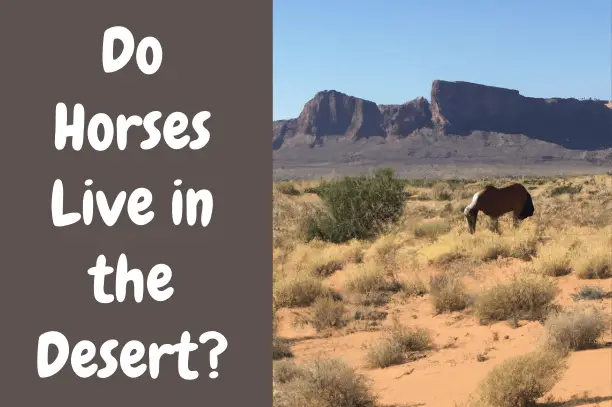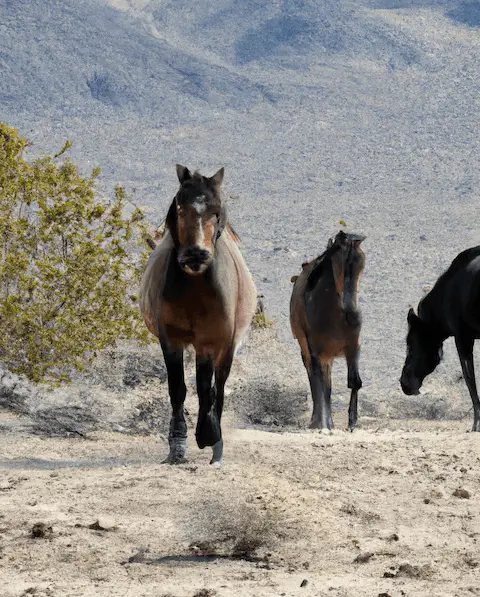Have you ever wondered if horses live in the desert? The truth is that horses can live in a variety of environments, and each type of terrain has its own unique benefits and drawbacks for these majestic animals.
So the answer is yes, there are some breeds of horses that are able to survive and thrive in desert climates.
Let’s now explore why these breeds are so well-adapted to living in the desert and how they manage to find food and water in such harsh conditions.
What Breeds of Horses Live in the Desert?
The most common breed of horse found in arid deserts is the Arabian, which is thought to have been domesticated as early as 4500 B.C. Arabians have evolved over time to become highly adapted to desert life.

They are small but agile, with short ears, wide nostrils, and a thick coat that helps them stay cool during hot days.
Other breeds of horses found in the desert include Barb, Paint Horse, Mustang, and Quarter Horse.
Wild Horse Diet
One of the things that set horses apart from other similar animals, like camels, is their incredible sense of smell.
This allows them to easily find food sources such as grasses and shrubs even if these plants are buried below the surface or partially covered by sand.
In the desert, finding water can be a challenge. To make up for this, horses are able to extract moisture from their food, keeping their bodies hydrated even without direct access to water.
So if they don’t find a natural source of water during the day, they will still have enough hydration to last them until sunrise and the next day’s foraging.
In addition to finding food and water, horses also have to contend with high temperatures and strong winds in the desert. They are able to cope with these conditions using a combination of behavioral adaptations and physical features.
For example, horses will often seek shade under trees or shrubs during the hottest parts of the day, and they will run quickly to get out of the sun’s direct rays.
In terms of physical adaptations, their large eyes help them see well at night in order to avoid predators, and their heavy fur coats provide protection from heat and wind when they are running across open desert landscapes.
Food & Water for Desert Horses
Horses are herbivores, meaning they eat mostly plant matter including grasses and grains. While grass can be difficult to come by in a desert environment, many horses supplement their diet with cacti and other succulent plants.

In some cases, horses may drink from natural bodies of water like streams or rivers, while in other cases they may need to locate a man-made water source like a watering hole or trough.
Although living in the desert presents certain challenges for horses, it is also an environment that is familiar and natural to them. So many horses manage to thrive in this harsh yet beautiful landscape by learning to adapt to their surroundings and make the most of the resources they have available.
Adapting to Extreme Temperatures
Desert temperatures can reach upwards of 110 degrees Fahrenheit during the summer months making it difficult for most animals to survive – but not horses.
Arabian horses have evolved over time to cope with extreme heat thanks to their thick coats and wide nostrils which help them cool down quickly after exercise or when exposed directly to sunlight.
When temperatures are lower, horses will often seek out shade under trees or shrubs in order to stay cool.
Many desert ranchers also provide shelter from direct sunlight for their horse herds using large tents or shaded areas such as trees or shrubs planted on their property.
Final Thoughts
So there you have it – horses do indeed live in the desert. As with most animals though, they cannot survive long without access to food and water.
Certain breeds like Arabian horses have adapted perfectly over time to living in this arid environment thanks to their thick coats and wide nostrils which help them stay cool even when exposed directly to sunlight.
With access to food sources and natural bodies of water as well as human-made watering troughs and shade provided by ranchers or farmers, these hardy wild horses can thrive in the desert environment.
And while they may have to contend with extreme temperatures and strong winds, their natural adaptations and physical features help them to survive and even thrive in this challenging yet beautiful landscape.

